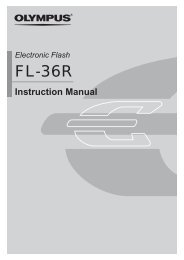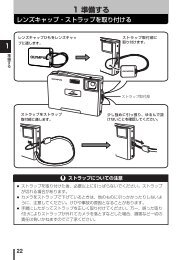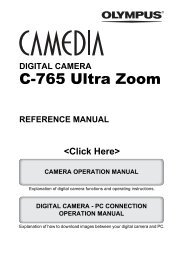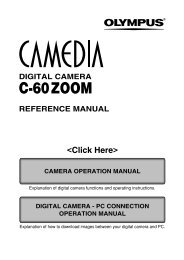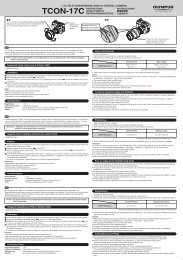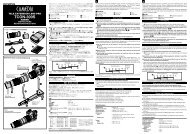Create successful ePaper yourself
Turn your PDF publications into a flip-book with our unique Google optimized e-Paper software.
If you encounter problems<br />
Possible cause Corrective action Ref. Page<br />
The picture is too dark.<br />
The subject was too small<br />
and was backlit.<br />
There was something<br />
bright in the center of the<br />
image.<br />
A high aperture value is<br />
set in the A (M) mode.<br />
A fast shutter speed is set<br />
in the S (M) mode.<br />
Set the metering system to spot metering. Or<br />
use the flash.<br />
When there is something bright in the center of<br />
the image, the whole image will be darker<br />
regardless of the metering system. Adjust the<br />
exposure toward +.<br />
Decrease the aperture value. Or set the<br />
exposure mode to the P mode.<br />
Reduce the shutter speed. Or set the exposure<br />
mode to the P mode.<br />
The colors of pictures taken indoors look unnatural.<br />
Indoor lighting affected<br />
the picture's colors.<br />
The white balance setting<br />
is wrong.<br />
Halation produces unnatural colors in the picture.<br />
This may be caused by<br />
excessively bright<br />
ultraviolet light on the<br />
subject, such as sunlight<br />
shining through the leaves<br />
of trees, brightly lit<br />
windows at night,<br />
reflections off metal in<br />
direct sunlight, etc.<br />
Set the appropriate white balance for the lighting.<br />
More natural-looking colors can be reproduced<br />
with the one-touch white balance.<br />
Set the appropriate white balance for the lighting<br />
again.<br />
● Use a UV filter. As this may upset the overall<br />
color balance, it should only be used under<br />
the conditions described on the left.<br />
● Process the picture using a graphics<br />
application that supports JPEG (Paint Shop<br />
Pro, Photoshop, etc.). For example, after<br />
picking up unnatural colors with an<br />
eyedropper tool, etc., you can select color<br />
areas, and try color conversion or saturation<br />
adjustment. For details, refer to the manual<br />
for the graphics application you are using.<br />
P. 54,<br />
87<br />
P. 88<br />
P. 43,<br />
45<br />
P. 43,<br />
47<br />
P. 93<br />
P. 93<br />
–<br />
179<br />
11<br />
Appendix




